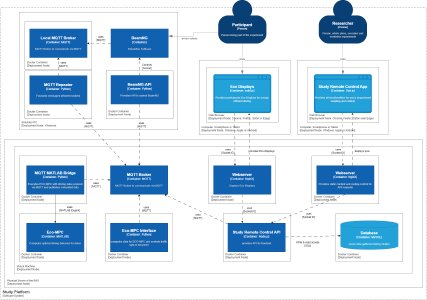The driving simulator
The climate crisis leads to the energy efficiency of transport systems being important feature. To this perspective, the Institute for Multimedia and Interactive Systems (IMIS), University of Lübeck, has developed a driving simulator for research in user-energy interaction of electric vehicles. The researchers of IMIS develop energy interfaces and energy efficiency automation strategies in the simulation to study driver interaction.
The simulator is suitable for testing energy interfaces, for assisting eco-friendly design and for studying eco-driving behavior. The hardware setup allows for an immersive driving experience of 180o FOV. The Ryzen Threadripper 3970X, GeForce RTX 3090 is being used.
 Architecture of the IMIS simulator
Architecture of the IMIS simulator
BeamNG.tech role
The soft-body physics simulation of BeamNG allows to model the kinematic properties of vehicles in a bottom-up way, since the overall dynamics of an object are dictated by the state of its individual components. As a result, vehicle behavior displays more realistic suspension, load distribution etc.
BeamNG simulation supports with:
- realistic vehicle dynamics modelling due to soft-body physics
- BeamNG Python API for driving data collection at real time. BeamNGpy comes with a wide range of low-level functions to interact with the simulation and a few higher-level interfaces that facilitate more complex actions.
- precisely simulated environment which is suitable for realistic driving experience
- Maps and scenarios developped with the tools WorldEditor and Flowgraph.
Publications
- Franke, T., Görges, D., & Arend, M. G. (2019, September). The Energy Interface Challenge. Towards Designing Effective Energy Efficiency Interfaces for Electric Vehicles. In Proceedings of the 11th International Conference on Automotive User Interfaces and Interactive Vehicular Applications (pp. 35-48).https://doi.org/10.1145/3342197.3344526
- Moll, V. E., & Franke, T. (2021). Biased energy efficiency perception based on instantaneous consumption displays–Indication for heuristic energy information processing. Applied Ergonomics, 94, 103399.https://doi.org/10.1016/j.apergo.2021.103399
- Jan Heidinger, Lukas Bernhardt, and Thomas Franke. 2023. Ecosimlab - A Low-Cost Driving Simulator Environment for Examining Human Factors in Vehicle Energy Efficiency. In Adjunct Proceedings of the 15th International Conference on Automotive User Interfaces and Interactive Vehicular Applications (AutomotiveUI ‘23 Adjunct). Association for Computing Machinery, New York, NY, USA, 66–70. https://doi.org/10.1145/3581961.3609881